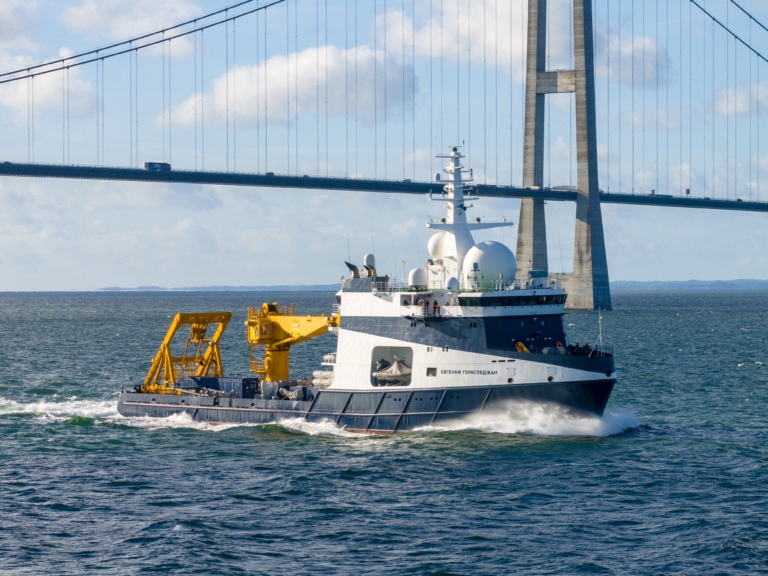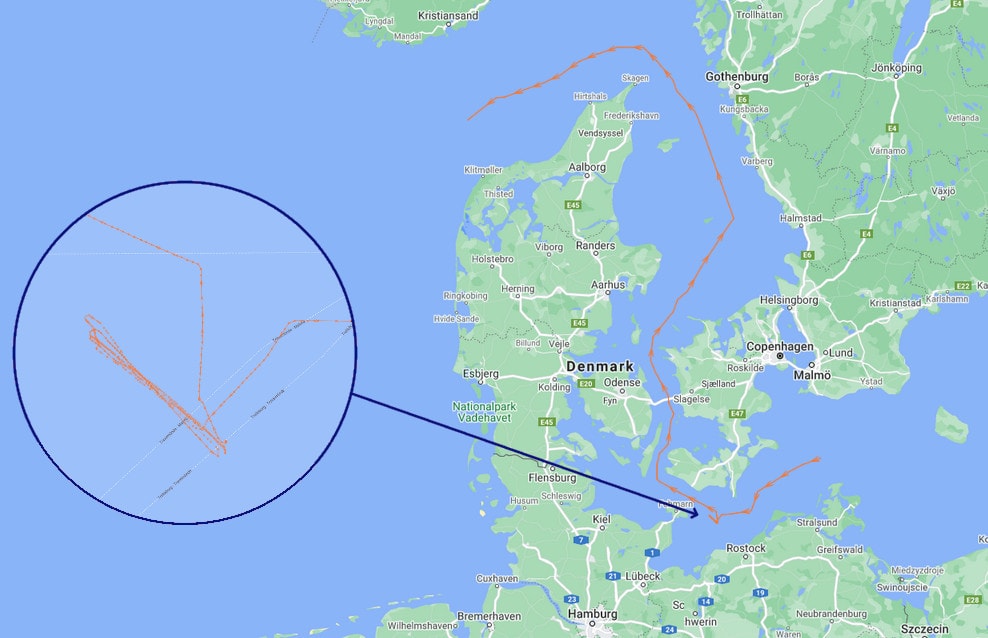
In October this year, a brand new Russian spy ship from GUGI, Putin’s top-secret military programme, left a shipyard in Kaliningrad and headed for Denmark.
The ship arrived in Danish waters on the evening of 14 October, and at 2 a.m. it stayed in the waters around Fehmarn for more than 24 hours, sailing in zigzag movements over a small piece of seabed.
Danwatch and Ekstra Bladet can reveal this today based on publicly available position data shared by the ship’s own AIS transmitter and described by several OSINT analysts on the social media X.
According to the data, it also took more than eight hours for the small German coastguard vessel “Neustadt” to arrive in the Fehmarn Belt and get close to the Evgeny Gorigledzhan, which is designed to map communication cables and pipelines on the seabed using two manned mini-submarines.
The spy ship is also capable of sabotaging critical infrastructure, and photos obtained by Danwatch and Ekstra Bladet show that soldiers on board were armed with machine guns.
The fact that a modern Russian spy ship has apparently been able to sail completely undisturbed in Danish waters puzzles Jens Wenzel Kristoffersen, lieutenant commander and military analyst at the Centre for Military Studies at the University of Copenhagen.
“Anyone sitting in a command centre and following ship traffic should be wondering about this. It’s not a civilian ferry, it’s a special unit! It should have immediately set off the loudest alarm bells.”
“It seems very, very strange that we don’t seem to be paying more attention to what’s going on. Based on the AIS data, it seems to take up to eight hours for a small German coastguard vessel to arrive. Eight hours in the middle of the night, with this vessel going back and forth, doing something. And you have to remember that this isn’t just anyone. GUGI is well-known. These are highly professional people,” he says.

Russian naval ships have the legal right to pass through Denmark, but it is unusual for them to make longer stops.
Danwatch and Ekstra Bladet have therefore asked a number of questions to the Defense Command (FKO) about Evgeny Gorigledzhan’s sailing in Danish waters, but the FKO states that it will not be able to answer until next week at the earliest.
Officially, the Evgeny Gorigledzhan is an oceanographic research vessel, but it belongs to the so-called Main Directorate of Deep Sea Research, also known as GUGI, which is a top-secret spy programme under Russia’s military, reporting directly to Putin and the general staff in Moscow.
Evgeny Gorigledzhan was officially launched in August this year at the Yantar shipyard in Kaliningrad, using – among other things – Danish materials. Through an official partner, the stone wool giant Rockwool has in 2018 and 2020 supplied ship insulation for approximately DKK 730,000 at the exchange rate of the time, which was to be used in Evgeny Gorigledzhan.
This is evident from documents from Russia’s official tender database, which Danwatch and Ekstra Bladet are in possession of.
At the time, the shipyard had issued several press releases stating that the ship would be part of GUGI’s fleet, which, in addition to intelligence vessels, also consists of several submarines and auxiliary ships.
Danwatch and Ekstra Bladet have asked Rockwool a number of questions about the deliveries, but Rockwool does not want to answer them and instead refers to the company’s website.
The first traces of Evgeny Gorigledzhan appeared on Saturday 14 October at 20:15, when the intelligence ship turned on its AIS transmitter as it approached Denmark’s internal waters.
A few hours later, at around 2 a.m., the ship began sailing back and forth across a small stretch of water in the Fehmarn Belt, where the future tunnel between Denmark and Germany will be located. Not until just before five in the morning on 16 October – more than 24 hours later – the Evgeny Gorigledzhan continues towards the Great Belt.
At around 11:30 a.m., the ship passes under the Great Belt Bridge, where several amateur photographers take pictures of it. And only after passing Anholt at around 8 p.m., the Danish patrol ship Diana comes alongside. According to the AIS data, Evgeny Gorigledzhan switches off its transmitter while the Danes spend the next three hours escorting the ship north of Læsø before it goes back to Frederikshavn.
Jens Wenzel Kristoffersen does not want to speculate on what the Russians have been doing at the Fehmarn Belt, but it seems “definitely suspicious,” he says.
“I can only say that the ship has not just been in transit. Nor is it normal for a ship of this category to sail back and forth on more or less the same opposite course for a long period of time, unless it is a diversionary manoeuvre and to attract the attention of the authorities.”
As Evgeny Gorigledzhan leaves the Skagerrak and sails into the North Sea, the AIS signal disappears again. The last known location of the ship was at 11:46 a.m. on Tuesday 17 October. But all indications are that the intelligence ship has continued towards the waters between the Netherlands and the UK. A spokesperson for the Dutch Ministry of Defense told Danwatch and Ekstra Bladet:
“We have been aware of this Russian vessel in the North Sea and the waters between the Netherlands and the UK. We have monitored the case thoroughly, but due to operational considerations we will not give more details for now.”
A spokesperson for the British Navy declined to comment on specific operations, but told Danwatch and Ekstra Bladet:
“We routinely monitor activity in UK waters and its Exclusive Economic Zone (EEZ) and maintain a presence to counter and deter potential threats.”
Ekstra Bladet and Danwatch have also tried to get a comment on Evgeny Gorigledzhan’s mission in Denmark through the Russian Embassy and Russia’s Ministry of Defense, but have not received a response at the time of publication.